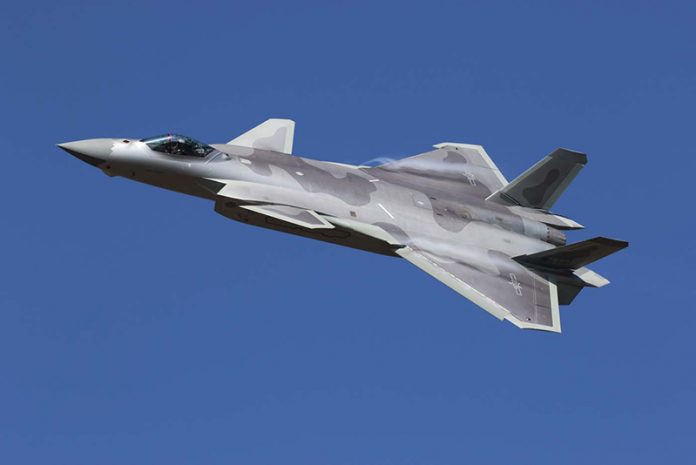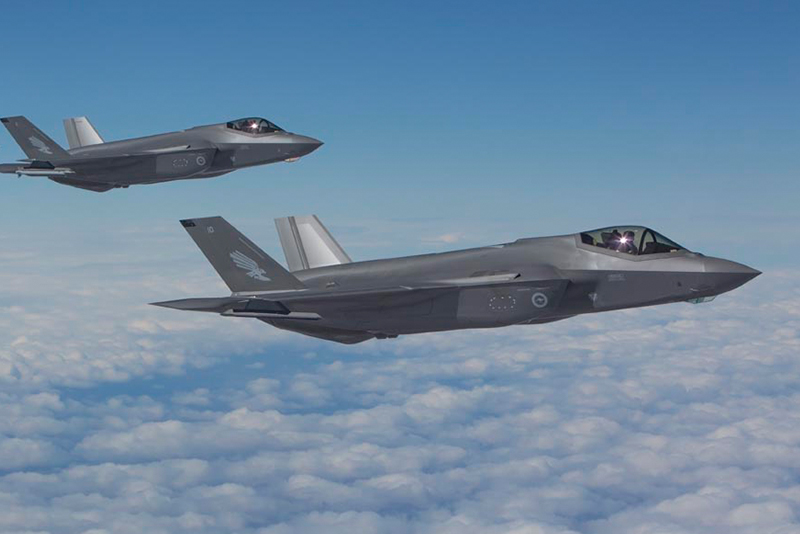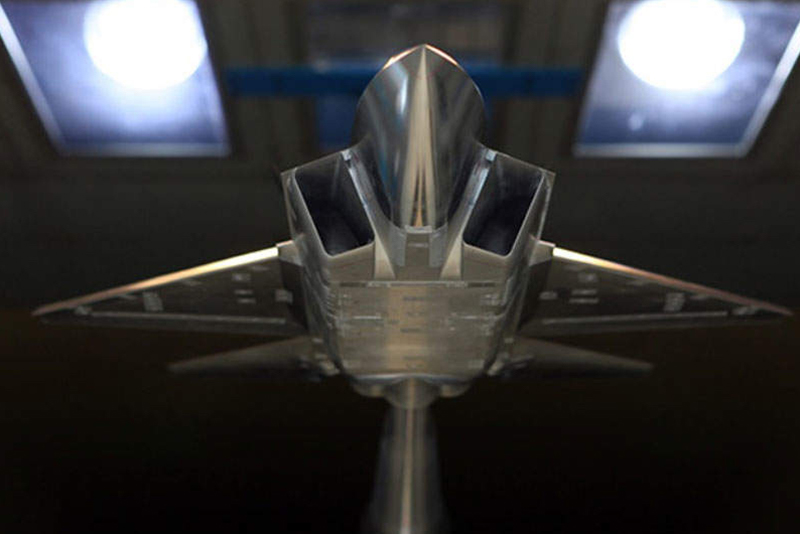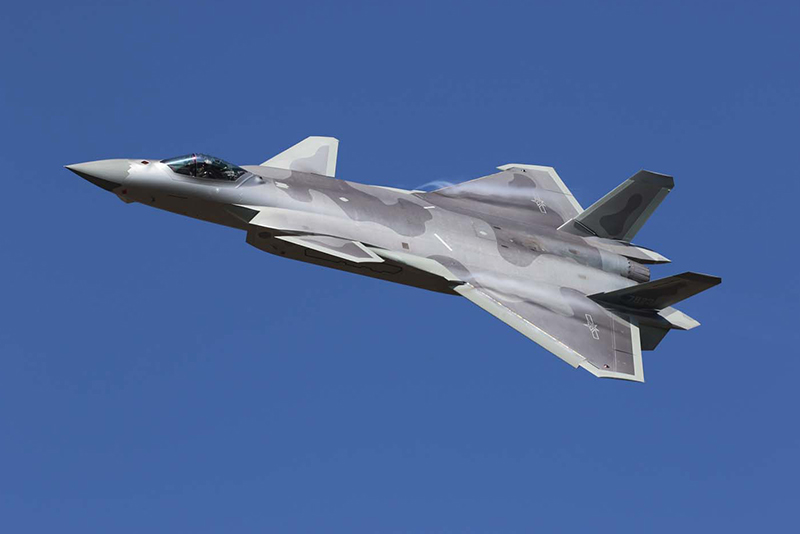
The selection of the F-35 by US defence partners in Asia shows how seriously the perceived threat from China’s own fifth generation Chegdu J-20 is being taken.
Lockheed Martin F-35
The only fifth generation fighter currently serving in Asia is the Lockheed Martin F-35 Lightning II Joint Strike Fighter. It sits at the forefront of air combat technology, and is the reason why Australia, Japan and South Korea have opted for it. But not everyone, such as Taiwan, can either afford or be a suitable customer for the F-35. Even if the United States agreed to sell to the Taiwanese armed forces, which is doubtful, there would be a massively adverse reaction from China.
Last January, the Singapore Ministry of Defence (MINDEF) announced it was set to purchase ‘a small number’ of F-35s for a full evaluation of the jet’s capability and suitability before opting for a full fleet. The following month, Singapore’s Defence Minister, Dr Ng Eng Hen told parliament, “We will replace the F-16s with the F-35 post 2030 and our initial letter of request [LOR] covers a purchase of four with an option for eight more if required.” He didn’t state which variant would be purchased.
Many nations aware of the resurgent China and on-off threats from North Korea are on their guard, and mindful of China’s own fifth generation fighter, the Chengdu J-20 now serving in the first operational unit. With its advanced sensors and data fusion, the F-35 can gather information and share it with other aircraft, ships and troops on the ground better than ever before. Enhancing an air force’s situational awareness and combat effectiveness is the name of the game today.
The Royal Australian Air Force
The Royal Australian Air Force (RAAF) ordered its first 14 F-35A Lightning IIs on 25 November, 2009 at a cost of over $2 billion (the full cost is officially set at $17 billion although this is being challenged by a report from the commonwealth auditor general’s office). It led to the first F-35A arriving in country on 10 December 2018.
Australia’s Minister for Defence, Christopher Pyne was at RAAF Williamtown when they arrived. Pyne told reporters: “This is the most advanced, multi-role stealth fighter in the world. It will deliver next generation capability benefits and provide a major boost to our intelligence, surveillance and reconnaissance capabilities,” adding, “the Joint Strike Fighter can get closer to threats undetected; find, engage and jam electronic signals from targets; and share information with other platforms.”
Planned Fleet RAAF
The total requirement is for 72 aircraft and to date 13 have been delivered to No 3 Sqn at Williamtown AFB, New South Wales. It is the first of two operational squadrons and a training squadron to be based at RAAF Base Williamtown and another squadron will stand up at RAAF Base Tindal. All 72 jets are expected to be fully operational by 2023 and further into the future, a fourth operational squadron is being considered for RAAF Base Amberley, pushing the total up to 100 F-35As.

No 3 Squadron is expected to reach initial operating capability (IoC) with the F-35A in 2020/21. Then 77 Squadron will, like 3 Sqn, replace its legacy F/A-18A/B Hornets with more F-35As.
There are 13 aircraft currently in Australia, another five are based at Luke AFB, Arizona where they are being used to train personnel. So far 48 aircraft have been contracted spanning Low Rate Initial Production (LRIP) 10 (ten aircraft), 11 (eight aircraft), 12 (15 aircraft) and 13 (15 aircraft). The RAAF F-35A’s current weapons load includes the Raytheon AIM-120-C7 AMRAAM, AIM-9X Sidewinder and GBU-31 Joint Direct Attack Munition (JDAM) all carried in the jet’s internal weapons bays.
Operating the F-35A alongside Australia in Asia Pacific are Japan and South Korea, which Minister Pyne claims “are closely aligned with Australia’s pursuit of shared strategic, security and economic interests.”
Japanese Air Self Defence Force
The F-35A has been in service with the Japanese Air Self Defence Force (JASDF) since March 2019. The 13 fighters currently delivered are operated by 302 Squadron at Misawa and will be followed later this year by the co-located 301 Squadron.
Japan faces the strategic rivalry of both China and an increasingly assertive Russia, however US President Donald Trump is also pressurising many US allies to spend more on their own defences. The Japanese MoD announced its selection as the JASDF’s next-generation fighter aircraft on 19 December, 2011 following the F-X competitive bid process.
The signing of an initial LOA (Letter of Offer & Acceptance), for four aircraft, was officially announced in June 29, 2012, with the Japanese Ministry of Defence stating that the cost of each F-35A amounts to approximately 1 $128 million.
Planned Fleet JASDF
There is a current total requirement for 42 aircraft. So far 34 have been contracted via LRIP 8 (four aircraft), LRIP 9 (two), LRIP 10 (four), LRIP 11 (six), LRIP 12 in Fy 2018 (six), LRIP 13 in FY 2019 (six) and LRIP 14 in FY 2020 (six).
Following assembly of the first four (AX-1 to AX-4) in the US, the remaining 38 are being assembled at Nagoya in Japan by Mitsubishi Heavy Industries (MHI). It was believed local production would cease after the aircraft ordered through LRIP-12, with future deliveries to come from the US production line in Fort Worth but the Japanese Government reportedly reversed that decision in December 2019 following cost cutting measures by MHI.
The four US-built aircraft were delivered to Luke AFB, AZ for training from August 2016 to March 2017 and transferred to Misawa in May 2018. Funding for 43 had been approved through to FY2020, the final aircraft being a replacement for the jet lost, with the pilot, off the coast of Japan on 9 April, 2019.
On 17 December, 2018 the Japanese cabinet approved a plan to add an additional 105 Lockheed Martin F-35s to its planned fleet of 42 aircraft.
In a press briefing, the chief cabinet secretary Yoshihide Suga confirmed that the country’s Medium Term Defence Program had been approved by the cabinet, covering 105 F-35As and 42 STOVL (Short Take Off and Landing) F-35B with some of the latter for the Navy. Japan has plans to deploy the F-35Bs along the edges of the South China Sea and East China Sea, evidenced by the JASDF’s retrofitting the Izumo-class carriers for amphibious operations.
The US Marine Corps (USMC) has based VMFA-121 with its F-35Bs at MCAS Iwakuni, Okinawa, which according to the Corps, sees ‘the fighters bringing strategic agility, operational flexibility, and tactical supremacy to III Marine Expeditionary Force.’ While F-35As from the 388th Fighter Wing at Hill AFB have also deployed to Kadena Air Base in Okinawa, which the USAF says ‘helps to demonstrate the continuing US commitment to stability and security in the region.’

The Republic of Korea Air Force
The Republic of Korea Air Force (ROKAF) currently has eight F-35As, operated by the 151st Fighter Squadron at Cheongju Air Base, of an initial 40 to be purchased that were announced on 24 March, 2014.
The first six aircraft were contracted under LRIP 10 (FY2016) and another ten more were contracted under LRIP 11 (FY2017). The first pair were delivered to Cheongju on 29 March, 2019 and were joined by a further two on 15 July.
On 10 October, 2019, the South Korean government announced it would begin the second phase of its plan to acquire additional Lightning IIs. Under F-X III, the RoKAF will get an extra 20 F-35As for $US 3.3 billion, with the aircraft expected to be delivered from 2021-2025.
KF-X a fifth generation fighter
South Korea has also been working over the past decade, on developing a fifth generation fighter, referred to as KF-X.
Last September, the Defense Acquisition Program Administration (DAPA) announced a critical design review (CDR) of the fighter and had given the go ahead for the construction of the prototype.

On 22 November, 2019, MBDA was awarded a contract by Korea Aerospace Industries (KAI) to integrate the Meteor beyond visual range air-to-air missile (BVRAAM) onto the KF-X. The deal includes integration support to KAI, transfer of technological know-how and manufacture of test equipment for the KF-X integration and trials campaign. Hanwha Systems is developing an AESA radar for the programme.
The People’s Liberation Army Air Force
The impressive looking Chengdu J-20 is China’s equivalent to the very capable Lockheed Martin F-22A Raptor, and the The People’s Liberation Army Air Force (PLAAF’s) first fifth generation aircraft.
It is a major concern to the US, and is now believed to be serving with three units, including at the Flight Test and Training Base at Dingxin, also known as the 176th Brigade, and the Flight Training Base in Cangzhou, referred to as the 172nd Brigade.
In early 2019, the first regular operation PLAAF unit to receive J-20s was the 9th Brigade at Wuhu, in the Eastern Theatre Command. An image released by the PLAAF showed a J-20 with the serial 62001, the first official acknowledgement that a new unit had been formed.
It is unclear how many have been delivered, as the PLAAF is keen to keep this secret, but at least 13 different serials have been identified.
Chengdu J-20 public display
The jet made its first public display at Zhuhai Air show in November 2016, but in November 2018 a three ship formation of J-20s were noted. Unsurprisingly there was no J-20 on the ground, but during the opening ceremony there was a glimpse of the J-20’s manoeuvrability.

Airshow spectators witnessed the three 172nd Regiment jets sweep by, with one (78231) pulling up as it passed the crowd and disappeared. The remaining pair (78232 and 78233) remained to demonstrate their formation skills with the spectacle of vapour pouring off the top of the wings. Eventually 78233 was left to display on its own exhibiting its stealthy look combined with all over jagged edges.
Chengdu J-20 Features
On the last day of the public flying display, on 12 November, four J-20s returned. During the final pass two of them opened their weapons bays to show four beyond visual range (BVR) PL-15s air to air missiles (AAMs) nestling inside.
These missiles are thought to house a small AESA radar and have a range of 200+kms (125+ miles). Alongside them were two short range PL-10s AAMs which are known to have a range of 20kms (12 miles).
These initial J-20s are being powered by an upgraded Russian Saturn AL-31 engines and not the WS-15 that was originally intended to power them. Issues with the latter has meant that a stopgap solution had to be found so the aircraft could be pushed into service in 2017, well ahead of schedule, because of increasing security challenges in the region.
In late December images appeared of new J-20s modified with the Shenyang WS-10B Taihang engine as a stop-gap for the original WS-15 powerplant. The latter cannot provide the thrust-to-weight ratio to push the J-20 to supersonic speeds, without the use of afterburners, which makes the jet un-stealthy.
The WS-10B features saw-toothed exhaust petals and is believed to power a handful of J-20s, as opposed to the AL-31 that has flush exhaust petals. The J-20 is thought to be equipped with an AESA radar, and at Zhuhai, a chin mounted electro optic sensor was evident, while it has been reported that there are six electro-optic apertures positioned around the aircraft, that form a passive detection system.
India
India, once a partner with Russia on the Su-57 (formerly known as PAK-FA), referred to as the Fifth Generation Fighter Aircraft (FGFA) has dropped the aircraft from its future plans.
According to reports, the aircraft’s poor low observability characteristics were the main reason. India might now be looking at the F-35 as an option or even longer term try to get on board the UK’s new Tempest programme.
Pakistan Fifth Generation Fighter Programme
India’s long-time foe, Pakistan is now working on a fifth generation fighter programme, known as Azm.
In November 2018, the PAF Chief of Air Staff, Air Chief Marshal Mujahid Anwar Khan told the author that it was part of his plans to build a broader and longer vision, he referred to as ‘Building a Next Generation PAF – 2047’, the significance of 2047 is that the PAF will be 100 years old.
“We have been working on a fifth generation fighter for almost a year now and it is likely to take several years before it is flying. It is an indigenous concept at this time – we are self-reliant and not dependent on Western or Eastern partners.” Although he didn’t exclude the possibility that China could get involved.
He continued: “It will be collaborated with private industry and our own academia. We are setting up our own aviation hub and now formulating our vision which will cover manufacturing facilities and laboratories. We have recently opened up a new university too, albeit in a make-shift location and we will link all of this to developing our own fifth/sixth generation fighter and commercial aircraft”.
by Alan Warnes










